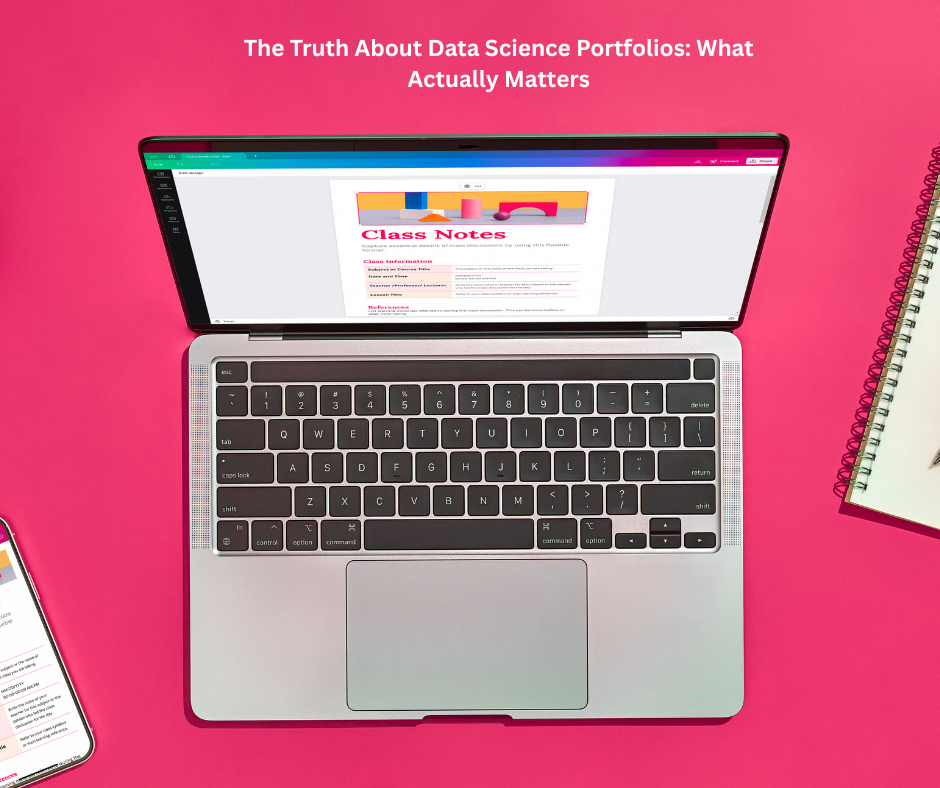
In the competitive world of data science, having a strong portfolio is no longer optional—it’s essential. Whether you're a recent graduate, a self-taught data enthusiast, or an experienced professional transitioning into data science, your portfolio can be the difference between landing an interview or getting overlooked. But with so much advice online, it’s hard to know what truly matters. In this article, we’ll cut through the noise and reveal the truth about data science portfolios: what actually matters to employers, recruiters, and hiring managers.
What Is a Data Science Portfolio?
A data science portfolio is a collection of projects, code samples, and analyses that showcase your skills in areas such as data wrangling, machine learning, data visualization, and communication. It serves as proof of your ability to work with real-world data and solve problems using data science tools and techniques.
Why a Data Science Portfolio Matters
When applying for data science roles, especially as a beginner, your resume alone may not stand out. Hiring managers want to see how you think, how you code, and how you approach problems. A portfolio is your chance to prove that you can:
- Handle real-world datasets
- Perform exploratory data analysis (EDA)
- Build and tune machine learning models
- Communicate insights effectively
More than degrees or certificates, a well-crafted portfolio builds trust. It tells potential employers that you have more than just theoretical knowledge—you’ve applied it.
The Myths About Data Science Portfolios
Before we dive into what truly matters, let’s bust a few common myths.
1. More Projects = Better Portfolio
Quantity doesn't beat quality. A portfolio with 10 basic projects isn’t better than one with 2-3 high-impact, in-depth projects. Employers prefer depth over breadth.
2. You Need to Use Cutting-Edge Tech
While it's great to explore technologies like deep learning or large language models, your portfolio doesn’t have to be full of AI buzzwords. Solid fundamentals—like feature engineering, EDA, and clear storytelling—matter more.
3. Kaggle Projects Are Enough
Kaggle is a great learning tool, but relying only on competition notebooks can hurt your chances. Most Kaggle projects don't reflect the full data science pipeline, such as data collection or stakeholder communication.
What Actually Matters in a Data Science Portfolio
Here’s what hiring managers are actually looking for when they review data science portfolios.
1. End-to-End Projects
The best portfolios showcase end-to-end solutions, from data collection and cleaning to model deployment or dashboard creation. This shows you understand the full lifecycle of a data science project.
2. Real-World Data
Using messy, real-world datasets (as opposed to clean, pre-packaged ones) demonstrates your ability to deal with the challenges professionals face on the job. Scraping data from APIs or public sources adds extra credibility.
3. Clear Problem Statement
Each project should answer a clear question or solve a defined problem. Employers should instantly understand what the project is about, why it matters, and what your conclusion was.
Example:
“Predicting house prices using regression” is too generic. Instead, try:
“Helping a real estate agency optimize their property pricing in New York using machine learning.”
4. Storytelling and Communication
Great data scientists are also great storytellers. Your portfolio should explain:
- What the problem is
- How you approached it
- The tools you used
- The results you found
- What the business impact would be
Consider using blog posts, Jupyter notebooks with markdown, or video explainers to enhance communication.
5. Readable, Clean Code
Hiring teams often evaluate your coding style. Clean, well-commented, and modular code signals professionalism. Use consistent naming conventions, avoid hardcoding values, and leverage version control (Git/GitHub).
6. Visualizations That Tell a Story
Data visualizations should be meaningful and insightful—not just pretty charts. Use them to support your conclusions and help viewers grasp your findings quickly.
7. Technical Breadth and Depth
A strong portfolio balances breadth across multiple tools (e.g., pandas, scikit-learn, SQL, Tableau, etc.) with depth in a few key areas, like time series forecasting, NLP, or classification.
8. Deployments and Dashboards
If possible, deploy your projects with tools like Streamlit, Flask, or Dash, and link them to your portfolio. This shows you understand how to make your models usable by others, a critical step in production environments.
How to Build a Great Data Science Portfolio
Here’s a roadmap to get started:
1. Pick Real-World Problems That Interest You
Passion projects stand out. Pick domains you care about—sports, health, climate, finance—and create projects that solve real problems using data.
2. Keep It on GitHub (or GitLab)
Use GitHub as your central portfolio. Organize your repositories well, include README files, and add instructions on how to run your code. Think of GitHub as your interactive resume.
3. Create a Personal Website
Showcase your projects in one place, along with a short bio, resume, and contact form. Use platforms like GitHub Pages, Notion, or WordPress. Add blog posts to boost your SEO and explain your work in depth.
4. Document Everything
Well-documented code and process notes demonstrate maturity. Include the tools you used, your thought process, challenges you faced, and how you solved them.
5. Get Feedback and Iterate
Share your portfolio with peers, mentors, or online communities (like Reddit or LinkedIn). Feedback can help you polish and improve before hiring managers see it.
Final Thoughts: Quality Over Quantity
A successful data science portfolio isn’t about quantity—it’s about quality, clarity, and impact. Employers want to see real-world problem solving, clean code, strong communication, and a deep understanding of the data science pipeline. Whether it’s through end-to-end projects, insightful storytelling, or well-documented GitHub repos, your portfolio should showcase how you think and the value you can bring. Enrolling in the best Data Science institute in Delhi, Noida, Goa, Pune, and other parts of India can provide the guidance and resources needed to build such a portfolio. Focus on fewer, high-quality projects that demonstrate your strengths, and always tailor them to your interests and target roles. In a competitive field, a thoughtfully built portfolio is your most powerful tool for standing out.